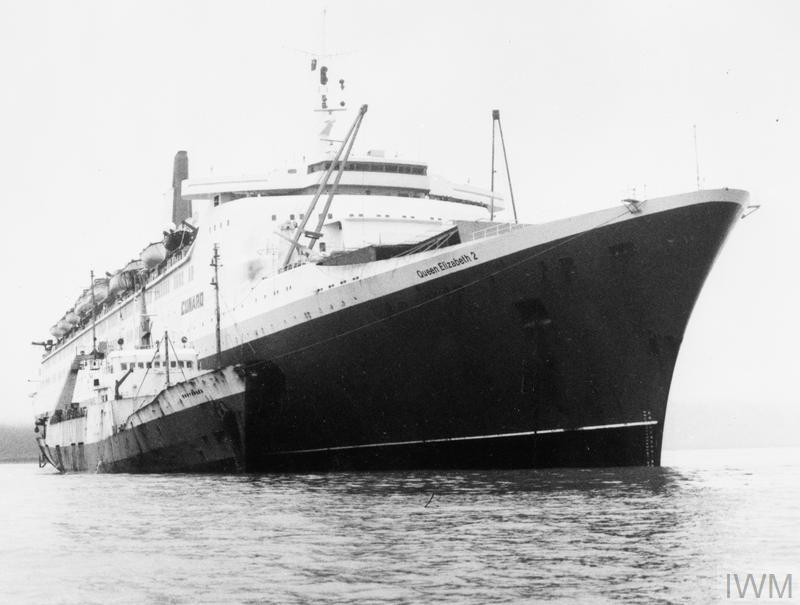Friday 28 May 1982 saw the completion of troop transfers between ships in South Georgia, including two of the UK’s most iconic passenger liners.
Queen Elizabeth 2, of Cunard, had brought the bulk of 5 Infantry Brigade to the remote South Atlantic island, but the ship could not be risked any closer to the conflict zone around the Falklands.
So her passengers were sent over to the P&O liner Canberra – known in the South Atlantic as the Great White Whale – the North Sea ferry Norland and stores ship RFA Stromness, the latter also loading ammunition and Rapier surface-to-air missiles which had been brought to South Georgia by the 12,000-ton merchant ship MV Lycaon, of the China Mutual Steamship line.
While the men were being ferried from ship to ship – the five trawlers of the 11th Mine Countermeasures Squadron and offshore patrol ship HMS Leeds Castle being particularly busy with this task – dispatch vessel Iris (a BT cable ship) arrived at Grytviken with a group of military personnel.
The ship then loaded up with scrap steel taken from the abandoned whaling stations on South Georgia and subsequently delivered it to the TRALA (Tug, Repair and Logistic Area) off the Falklands where it was used in repairing ships and equipment.
The Scots and Welsh Guards were predominantly accommodated in Canberra, the Gurkhas in Norland, and while they headed west to the Falklands, QE2 headed north with survivors of HMS Coventry, HMS Ardent and HMS Antelope on Saturday 29 May.
Following her out was Leeds Castle, which sailed as far as Ascension Island where she took up duties as guardship.
In the Falklands, Fleet Clearance Diving Team 1 (FCDT1) managed to remove the second unexploded 1,000lb bomb from frigate HMS Argonaut, while colleagues from FCDT3 continued to clear the debris and wreckage that were preventing them reaching the unexploded bomb lodged in Landing Ship Logistic RFA Sir Lancelot.
FCDT3 had also investigated unexploded bombs in the vicinity of the field hospital in Ajax Bay, one of the landing beaches on San Carlos Water, and built a sandbag wall between two bombs and the hospital – members of the team camped down between the hospital and the sandbag blast wall to reassure medics and patients that the structure would be sound.
Ashore, troops of 2 Parachute Regiment launched an attack on the Argentine military camp at Port Darwin and the airstrip at Goose Green.
Soldiers had been moving to the various starting positions overnight, and began their advance from the north of the narrow isthmus at the top of Choiseul Sound around 0330.
Enemy trenches and strongpoints at Boca House and Darwin Hill slowed the advance down as dawn broke, and there was no breakthrough till around midday.
Lt Col ‘H’ Jones, 2 Para Commander, took the initiative by charging almost single-handed up a small gully or ravine, and was fatally wounded in an action that led to the award of the Victoria Cross.
Reinforcements and supplies were flown in to Argentine positions, and Pucara light attack aircraft flew support missions, catching two Scout helicopters of 3 Commando Brigade Air Squadron which were flying in supplies and ammunition and returning to the British beachhead with casualties.
One helicopter escaped, and the other, piloted by Royal Marine Lt Richard Nunn,
managed to evade the first Pucara through skilful flying, but his Scout was hit in a second attack and he was killed instantly, while his crewman, Sgt Bill Belcher, was badly wounded in the legs.
Lt Nunn was posthumously awarded the Distinguished Flying Cross.
Under the command of Maj Chris Keeble, the paratroopers again began to make headway, though they were forced to fight hard for the higher ground along the way.
By late afternoon Harrier GR3s were supporting the advance, and also attacking anti-aircraft guns at Goose Green, while accurate mortar fire from the British side was causing heavy casualties amongst the Argentine defenders.
As evening rolled round the paratroopers had forced Argentine troops back into the Goose Green area, but their position was not a strong one – they were short of food, water and ammunition, and were cold and tired.
Maj Keeble believed offering the Argentinians a surrender might be worth a try, and once his plan was approved a message was sent to the Argentine local commander via the CB radio of a civilian in Goose Green, stating that a delegation would be sent from the British side with a message.
The Argentine commander agreed to meet with the delegation, which reached him shortly after midnight…
With the fighting over (for now), British losses on the ground amounted to 15 paratroopers and a Royal Engineer, with up to 40 wounded.
Further north, Royal Marines of 45 Commando yomped to Douglas, digging in the following day, while soldiers of 3 Para tabbed to Teal Inlet, south east of the Royals, both encountering boggy terrain and wet weather but nothing by way of resistance from enemy troops.
J Coy 42 Cdo were flown by helicopter to Darwin, while an SAS squadron flew to Mount Kent, on the approaches to Stanley.
Today’s image, from the extensive Imperial War Museum collection (© IWM FKD 527) shows HMS Northella alongside Queen Elizabeth 2 in South Georgia during the ship-to-ship transfer of the 5th Infantry Brigade.
* These posts can only give a brief sense of what was a complex and fast-moving situation 40 years ago, and cannot cover the involvement of every ship, squadron and unit in detail – for a much more comprehensive account see the Falklands section of naval-history.net at https://www.naval-history.net/NAVAL1982FALKLANDS.htm
